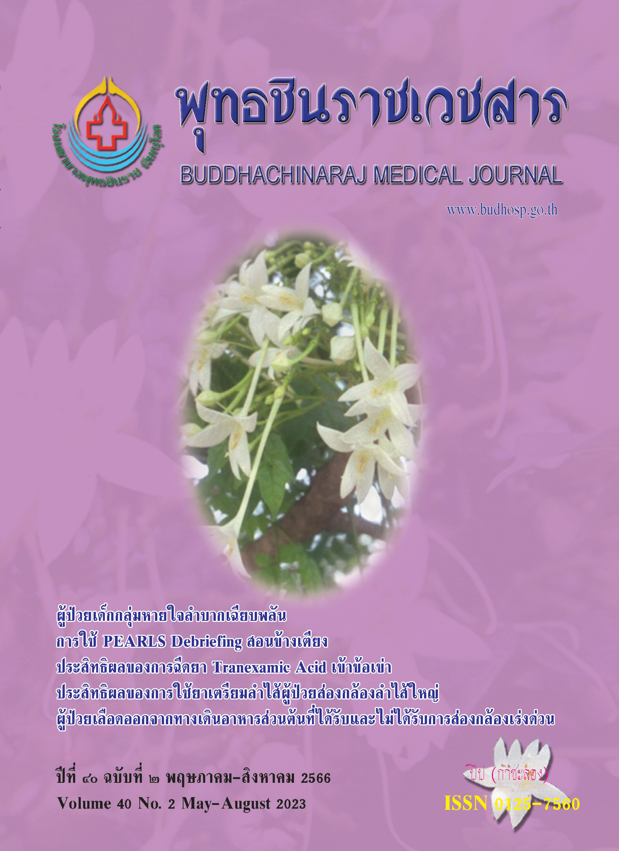ผลลัพธ์ทางคลินิกและค่าใช้จ่ายของผู้ป่วยเลือดออกจากทางเดินอาหารส่วนต้น ที่ได้รับและไม่ได้รับการส่องกล้องเร่งด่วน
ผู้ป่วยเลือดออกจากทางเดินอาหารส่วนต้นที่ได้รับและไม่ได้รับการส่องกล้องเร่งด่วน
คำสำคัญ:
ภาวะเลือดออกในทางเดินอาหารส่วนต้น, การส่องกล้องทางเดินอาหารส่วนต้น, ผลลัพธ์ทางคลินิก, ค่าใช้จ่ายบทคัดย่อ
ผู้ป่วยเลือดออกในทางเดินอาหารส่วนต้นเฉียบพลันที่มีความเสี่ยงสูง ควรได้รับการส่องกล้องเพื่อวินิจฉัยและ รักษาภายใน 24 ชั่วโมง (early EGD) โครงการส่องกล้องนอกเวลาราชการ 8 ชั่วโมงต่อวันของกลุ่มงาน อายุรกรรม โรงพยาบาลพุทธชินราช พิษณุโลกเริ่มเมื่อวันที่ 1 ตุลาคม พ.ศ. 2562 การศึกษาแบบย้อนหลังนี้มีวัตถุประสงค์เพื่อเปรียบเทียบ ผลลัพธ์ทางคลินิกและค่าใช้จ่ายของผู้ป่วยเลือดออกในทางเดินอาหาร ส่วนต้นที่ได้รับและไม่ได้รับการส่องกล้องเร่งด่วน (ได้รับการส่องกล้อง หลัง 24 ชั่วโมง : delayed EGD) พบว่าก่อนจัดทำและหลังเริ่มโครง การฯ หนึ่งปีมีผู้ป่วยในหอผู้ป่วยอายุรกรรมซึ่งมีภาวะเลือดออกที่มีความ สำคัญทางคลินิก 876 ราย อายุเฉลี่ย 60.2 ปี เป็นเพศชายร้อยละ 75.5 จำนวนผู้ป่วยกลุ่ม early EGD เพิ่มขึ้นจากร้อยละ 50 เป็นร้อยละ 80 ค่า มัธยฐานของเวลาที่ได้รับการส่องกล้องในกลุ่ม early EGD และในกลุ่ม delayed EGD คือ 1 วัน และ 2 วัน โดยผู้ป่วยกลุ่ม early EGD ได้รับ การรักษาผ่านกล้องมากกว่าค่ามัธยฐานของระยะเวลานอนโรงพยาบาล ของทั้งสองกลุ่มคือ 4 วัน (p < 0.001) อย่างไรก็ตามเลือดและผลิตภัณฑ์เลือดที่ผู้ป่วยได้รับ การปรึกษารังสีร่วมรักษา การปรึกษา ศัลยกรรม อัตราการเกิดเลือดออกซ้ำใน 30 วัน อัตราตายของทั้งสอง กลุ่ม รวมถึงค่าใช้จ่ายในการนอนโรงพยาบาล (ค่ารักษากับค่าล่วงเวลา ของเจ้าหน้าที่) ไม่แตกต่างกัน สรุปได้ว่าการส่องกล้องนอกเวลาราชการ 8 ชั่วโมงต่อวันสามารถเพิ่มการเข้าถึงการรักษามาตรฐานของผู้ป่วยได้ โดยผลลัพธ์ทางคลินิกและค่าใช้จ่ายไม่แตกต่างกัน
เอกสารอ้างอิง
Pang SH, Ching JY, Lau JY, Sung JJ, Graham DY, Chan FK. Comparing the Blatchford and pre-endoscopic Rockall score in predicting the need for endoscopic therapy in patients with upper GI hemorrhage. Gastrointest Endosc 2010;71(7):1134-40.
Khamaysi I, Gralnek IM. Acute upper gastrointestinal bleeding (UGIB)-initial evaluation and management. Best Pract Res Cl Ga 2013;27(5):633-8.
Barkun AN, Almadi M, Kuipers EJ, Laine L, Sung J, Tse F, et al. Management of nonvariceal upper gastrointestinal bleeding: guideline recommendations from the International Consensus Group. Ann Intern Med 2019;171(11):805-822.
Fujishiro M, Iguchi M, Kakushima N, Kato M, Sakata Y, Hoteya S, et al. Guidelines for endoscopic management of non-variceal upper gastrointestinal bleeding. Gastroenterol Endosc Soc 2016;28(4):363-78.
Laursen SB, Leontiadis GI, Stanley AJ, Møller MH, Hansen JM, Schaffalitzky de Muckadell OB. Relationship between timing of endoscopy and mortality in patients with peptic ulcer bleeding: a nationwide cohort study. Gastrointest Endosc 2017;85(5):936-44.e3. https://doi.org/10.1016/j.gie.2016.08.049
Laine L, Jensen DM. Management of patients with ulcer bleeding. Am J Gastroenterol. 2012;107(3):345-60;quiz 361. https://doi.org/10.1038/ajg.2011.480
Hwang JH, Shergill AK, Acosta RD, Chandrasekhara V, Chathadi KV, Decker GA, et al. The role of endoscopy in the management of
variceal hemorrhage. Gastrointest Endosc 2014;80(2):221-7.
Cook DJ, Griffith LE, Walter SD, Guyatt GH, Meade MO, Heyland DK, et al. The attributable mortality and length of intensive care unit stay of clinically important gastrointestinal bleeding in critically ill patients. Crit Care 2001;5(6):368-75.
Blatchford O, Murray WR, Blatchford M. A risk score to predict need for treatment for upper-gastrointestinal haemorrhage. Lancet 2000;356(9238):1318-21.
Charlson ME, Pompei P, Ales KL, MacKenzie CR. A new method of classifying prognostic comorbidity in longitudinal studies: development and validation. J Chron Dis 1987;40(5):373-83.
Forrest JA, Finlayson ND, Shearman DJ. Endoscopy in gastrointestinal bleeding. Lancet 1974;2(7877):394-7.
Gralnek IM, Stanley AJ, Morris AJ, Camus M, Lau J, Lanas A, et al. Endoscopic diagnosis and management of nonvariceal upper gastrointestinal hemorrhage (NVUGIH): European Society of Gastrointestinal Endoscopy (ESGE) Guideline – Update 2021. Endoscopy 2021;53(3):300-32. https://doi.org/10.1055/a-1369-5274
Laine L, Barkun AN, Saltzman JR, Martel M, Leontiadis GI. ACG Clinical Guideline: Upper gastrointestinal and ulcer bleeding. Am J Gastroenterol 2021;116(5):899-917. https://doi.org/10.14309/ajg.0000000000001245
Sirisunhirun P. Incidence and factors associated with high risk upper gastrointestinal bleedingin King Narai Hospital. J Health Environ Educ 2001;6(1):36-44.
Kanno T, Yuan Y, Tse F, Howden CW, Moayyedi P, Leontiadis GI. Proton pump inhibitor treatment initiated prior to endoscopic diagnosis in upper gastrointestinal bleeding. Cochrane DB Syst Rev 2022;1(1):CD005415. https://doi.org/10.1002/14651858.CD005415.pub4
Shin JM, Kim N. Pharmacokinetics and pharmacodynamics of the proton pump inhibitors. J Neurogastroenterol Motil 2013;19(1):25-35. https://doi.org/10.5056/jnm.2013.19.1.25
Stanley AJ, Laine L. Management of acute upper gastrointestinal bleeding. BMJ. 2019;364:l536. doi: https://doi.org/10.1136/bmj.l536
Garg SK, Anugwom C, Campbell J, Wadhwa V, Gupta N, Lopez R, et al. Early esophagogastroduodenoscopy is associated with better outcomes in upper gastrointestinal bleeding: a nationwide study. Endosc Int Open 2017;5(5):E376-e86. https://doi.org/10.1055/s-0042-121665
ดาวน์โหลด
เผยแพร่แล้ว
ฉบับ
ประเภทบทความ
สัญญาอนุญาต
ลิขสิทธิ์ (c) 2023 ``โรงพยาบาลพุทธชินราช พิษณุโลก

อนุญาตภายใต้เงื่อนไข Creative Commons Attribution-NonCommercial-NoDerivatives 4.0 International License.






